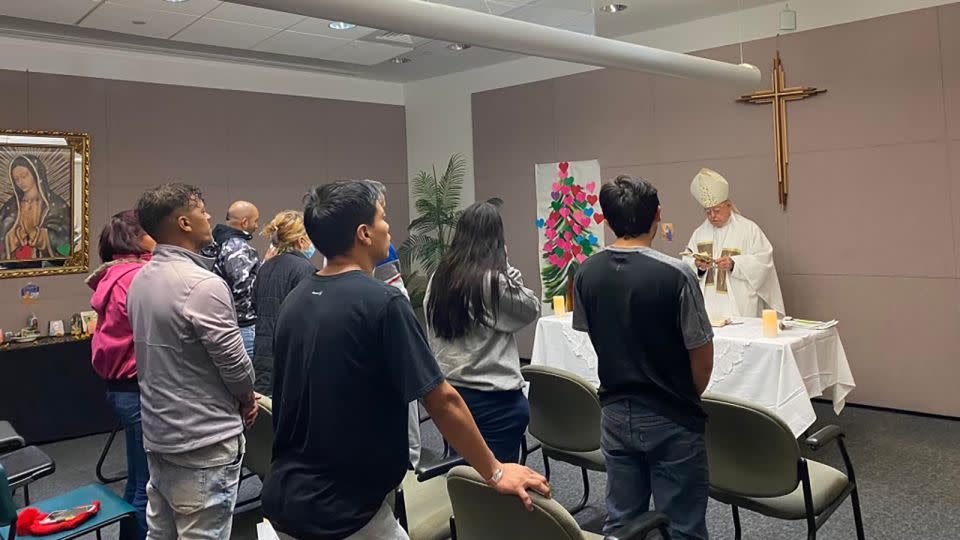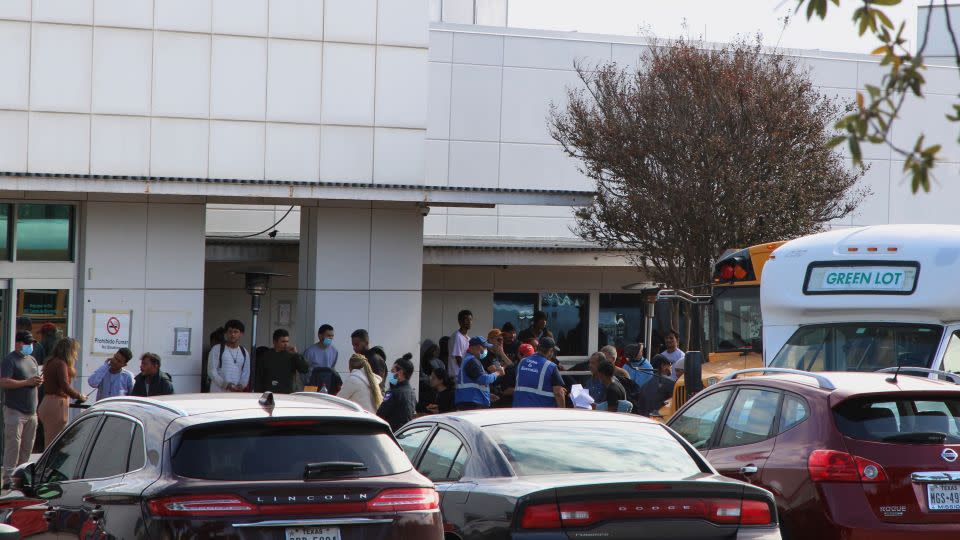Cities desperately need money to handle the migrant surge. Congress recently gave them less
If Catholic Charities of San Antonio doesn’t soon get more federal funding aimed at supporting asylum-seekers, it will have to close its Migrant Resource Center during the evening and overnight hours, which could leave busloads of newly arrived immigrants on the streets.
The nonprofit received $55 million from the Federal Emergency Management Agency program in the prior fiscal year, which it used to provide more than 220,000 people with temporary shelter, food and clothing, legal services, counseling and transportation to their final destination. But it only has $5.7 million left, so it is considering slashing the welcome center’s hours in coming weeks to preserve its ability to help migrants during the day for the rest of the year.
Congress last month approved the fiscal year 2024 funding level for FEMA’s Shelter and Services Program in the federal funding package, nearly six months into the fiscal year. Cities, counties and states around the nation have repeatedly asked the federal government for more money to handle the surge of migrants entering the US, and the Biden administration last year called on lawmakers to pump an additional $600 million into the program. The program has not been able to provide any additional financial support since late 2023.
But instead, lawmakers cut the program’s funding to $650 million, down nearly 20% from the prior year. The House and Senate appropriations committees did not return requests for comment.
Rep. Joaquin Castro, a Democrat who represents San Antonio, said that immigration is a federal responsibility.
“Cities need more help – not less,” he said in a statement to CNN. “Funding from the Shelter and Services Program (SSP) has helped Catholic Charities and other groups in my city of San Antonio offer basic migrant services without straining local resources. Asylum-seekers are fleeing from some of the worst violence and oppression we can imagine, and nobody wants to see them sleeping on the streets.”

The San Antonio charity is still waiting to hear how much funding it may receive for this fiscal year, and its CEO, Antonio Fernandez, traveled to Washington, DC, in early April to petition FEMA for more money. But even if the funds arrive in time to keep the center open 24 hours a day, the nonprofit is expecting to have to pull back its services and possibly reduce staff. That would likely mean it would take longer for the new arrivals to be processed and could compromise the security of the hundreds of people temporarily staying at the welcome center.
“We cannot function like we used to do last year,” said Fernandez, adding that he plans to ask the city of San Antonio for assistance. “Even if we get the money, with a 20% cut, then we will have to cut services. If there’s a surge in immigrants, then it’s going to be a difficult situation.”
Cities and counties are now scrambling to figure out how they will cope with the reduction in FEMA funding at a time when the number of migrants at the US-Mexico border is at or near record levels. Migrants are released from federal custody after thorough vetting, and they go through immigration court proceedings where an immigration judge decides whether they can remain in the US or be deported.
In fiscal year 2023, the FEMA funding went to Atlanta; Chicago; New York City; Albuquerque, New Mexico; and Laredo, Texas, among other cities. It also went to Riverside County, California, and Pima County, Arizona, among other counties, and a multitude of religious and nonprofit groups, including Catholic Charities in multiple cities, several food banks and the United Way in several locations, among others.
Municipalities and states around the US are now affected, partially because GOP Texas Gov. Greg Abbott has been busing people to Democratic-led cities in the north in recent years.
The funding cut also comes at a time when Senate Republicans are blocking a bipartisan border deal that would have given the president more power to curb illegal migrant crossings at the southern border.
FEMA will publish in coming weeks more information so communities and organizations can apply for the $650 million pot of funds, according to the Department of Homeland Security, which oversees FEMA. But it won’t be enough.
“Due to the substantial demand that exceeds the limited SSP program funding authorized by Congress, not all requests can be fulfilled,” a DHS spokesperson told CNN. “That is why we continue to call on Congress to pass the bipartisan border security agreement, which would in part provide an additional $1.4 billion in SSP funds.”
Tough choices
Lawmakers’ decision to cut the funding is not responding to the need, said Mark Ritacco, chief government affairs officer at the National Association of Counties.
“The reduced appropriations for SSP grants will likely require counties to divert resources from other programs,” he said, noting that counties provide law enforcement, emergency services, health care, parks and sanitation, among other services.
John Giles, mayor of Mesa, Arizona, is preparing for churches and nonprofits in his city to ask for help assisting the busloads of migrants who are dropped off by US Customs and Border Protection on their way to other locations. The city will have to consider its options, such as tapping into its general fund or providing less assistance to asylum-seekers.
“The notion that in any way it makes sense to decrease funding in time of crisis is just nonsensical,” said Giles, who is chair of the US Conference of Mayors’ immigration reform task force. “I can’t imagine that the answer is we’ll turn our backs on the situation. But that, apparently, is what the federal government is encouraging us to do.”
In San Antonio, Mayor Ron Nirenberg said he’s been pushing for more money to help migrants, not less. He asked President Joe Biden for additional funding when the president visited Texas in March and sent a letter to San Antonio’s congressional delegation and the Department of Homeland Security last year requesting an additional $57.5 million for the Migrant Resource Center.

The city does not yet know how much it will receive from the FEMA program, nor does it know how many migrants will pass through San Antonio. Officials have begun discussing contingency plans if the assistance falls short of the need.
“We will seek to use federal funds rather than dip into local funds that pay for police, firefighters and our streets,” said Nirenberg, noting that Covid-19 relief funds are one option.
CNN’s Priscilla Alvarez contributed to this report.
For more CNN news and newsletters create an account at CNN.com

